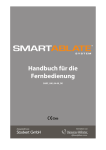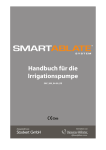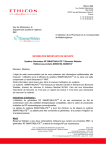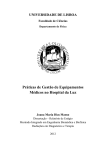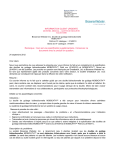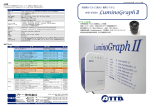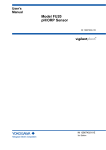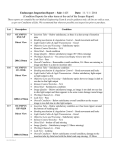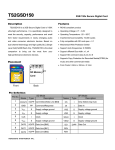Download Remote Control User Manual - STOCKERT medical solutions
Transcript
Remote Control User Manual SARC_UM_04-00_EN Remote Control User Manual Table of Contents Prefaceiii 1Indications 1 2Warnings 2 3 4 Remote Control Overview and Setup 3.1Controls on the Front of the Remote Control................................................................................... 4 3.2Controls on the Back of the Remote Control.................................................................................... 5 3.3Functional Test and On-Site Training................................................................................................... 5 3.4Setup............................................................................................................................................................... 6 3.4.1 Setting Up the Remote Control............................................................................................. 6 3.4.2 Mains Connection....................................................................................................................... 6 3.4.3Circular Plug Connections....................................................................................................... 6 3.4.4 Serial Data Connections........................................................................................................... 6 3.4.5 Tilting the Remote Control...................................................................................................... 7 3.4.6Connection to the SmartAblate™ RF Generator............................................................... 7 3.5Cleaning and Disinfecting the Remote Control............................................................................... 7 3.6 Protecting Against Damage.................................................................................................................... 8 3.7Disposal.......................................................................................................................................................... 8 4Accessories 4.1 9 Diagram of the Remote Control and Accessories........................................................................... 9 4.2Accessory Lists...........................................................................................................................................10 4.2.1Foot Pedal....................................................................................................................................10 4.2.2 SmartAblate™ Cables...............................................................................................................10 4.3Caring for Accessories.............................................................................................................................11 4.3.1Connection Cables...................................................................................................................11 4.3.2Foot Pedal....................................................................................................................................11 4.4Cleaning, Disinfecting, and Sterilizing Accessories......................................................................11 5 Remote Control Operation 12 5.1Remote Control Startup.........................................................................................................................12 5.2Remote Control Shutdown...................................................................................................................13 5.3Assigning the System Master...............................................................................................................13 5.4 Volume, Brightness, and Foot Pedal Test.........................................................................................14 6Troubleshooting 15 6.1 Problems with Connection to the Generator.................................................................................15 6.2 Other Troubleshooting...........................................................................................................................15 6.3Calibrating the Touch Screen...............................................................................................................16 i Remote Control User Manual 7 Technical Data 17 7.1Specifications.............................................................................................................................................17 7.2 Storage and Shipping Conditions......................................................................................................17 7.3 Operating Conditions.............................................................................................................................17 7.4 Safety Inspections....................................................................................................................................17 7.5Maintenance...............................................................................................................................................18 7.6Repairs..........................................................................................................................................................18 7.7Conformance to Standards...................................................................................................................19 7.8EMC Information and Technical Description..................................................................................20 8Symbols 25 9Warranty 27 9.1 Transit Damage.........................................................................................................................................27 9.2Warranty.......................................................................................................................................................27 9.3 Product Liability........................................................................................................................................27 ii Remote Control User Manual Preface The SmartAblate™ Remote Control is an accessory for the SmartAblate™ RF Generator. The physical appearance and the user interface of the two devices are almost identical. However, the remote control is not designed to connect to patient cables such as catheter cables and indifferent electrode cables. The SmartAblate™ Remote Control allows remote control of the SmartAblate™ RF Generator from outside the patient area. The SmartAblate™ Remote Control was designed to ensure simple, intuitive, and user-friendly operation. This accessory features a touch screen for making selections and setting parameters. Critical safety functions are controlled by buttons that are operated independently of the touch button has priority over all other functions and connected devices, screen. A prominent red Stop thus immediately stopping RF energy delivery when pressed. Use of the SmartAblate™ Remote Control requires familiarity with the device and its operation. Before using the remote control, the user should read this user manual and the user manual for the SmartAblate™ RF Generator. For more information on training options, please contact Biosense Webster. We will gladly answer any questions that you may have. Yours truly, STOCKERT GmbH iii Remote Control User Manual 1 Indications See the SmartAblate™ RF Generator User Manual for indications that apply to the SmartAblate™ RF Generator and the SmartAblate™ Remote Control. 1 Indications | Page 1 Remote Control User Manual 2 Warnings Note: The warnings in this section cover the SmartAblate™ Remote Control specifically. See the SmartAblate™ RF Generator User Manual for additional warnings. 1. Read this user manual carefully before using the SmartAblate™ Remote Control for the first time. Note especially the instructions in Section 3.4, Setup. 2. Always verify that the remote control’s visual and acoustic alarms are working before using the remote control (see Section 5.1, Remote Control Startup). 3. When the remote control has been turned off, power continues to be supplied to the remote control through the mains cable. To completely cut off power to the remote control, disconnect the mains cable from the remote control. To allow easy disconnection in the event of severe power failure, make sure that the remote control is located where there is easy access to the mains cable on the back of the remote control. 4. After turning on the remote control, always wait until the automatic self test has been successfully completed and the remote control has been made the Master of the system (see Section 5.3, Assigning the System Master) before starting the first steps of the procedure on the patient (for example, before anesthesia or before creating percutaneous access). Also, if using accessories that connect to the remote control, verify that the connections to those systems are functional prior to starting the first steps of the procedure. Doing this helps to detect problems with the device before the patient is in a phase of the intervention in which interruption could lead to an increased risk to the patient’s health. 5. Use only accessories that have been provided by or recommended by the remote control’s manufacturer (see Chapter 4, Accessories). The use of other accessories can have a negative effect on the technical specifications. Do not modify accessories. Visually inspect all accessories on a regular basis. Make sure that the connected cables are not damaged. 6. Make sure that the cable to the SmartAblate™ RF Generator is properly connected and that the remote control can be moved easily without disconnecting it from the generator (see Sections 3.4.1, Setting Up the Remote Control and 3.4.3, Circular Plug Connections). 7. Place the remote control on a secure, non-slip surface as described in Section 3.4.1, Setting Up the Remote Control. Make sure that there is enough free space on all sides of the remote control to allow the heat created by the remote control to escape. 8. Other electrical devices can influence the function of the remote control if they are operated at the same time in the immediate vicinity of the remote control. 9. To avoid damage to the connection cables, do not wrap the cables around the remote control or other apparatus. Coiling the connection cables during normal operation of the remote control creates inductive components, which can lead to interruption of the operation of the remote control. 2 Warnings | Page 2 Remote Control User Manual 10. Special safety measures with regard to electromagnetic compatibility (EMC) must be taken with electrical medical devices. This equipment generates, uses, and can radiate radiofrequency energy and, if not installed and used in accordance with the user manual, may cause harmful interference to radio communications. Similarly, portable and mobile communication devices may cause harmful interference to the functioning of the remote control. 11. If error messages repeatedly appear, stop using the remote control and contact Customer Support. 12. To avoid damage to the remote control and its accessories, use only appropriate cleaning agents (see Sections 3.5, Cleaning and Disinfecting the Remote Control and 4.3, Caring for Accessories). 13. To avoid the risk of electric shock, connect the mains cable from the remote control mains socket (see Item 1 in Section 3.2, Controls on the Back of the Remote Control) to a 3-prong outlet that meets the specifications in Section 7.1, Specifications. 14. The remote control may be opened only by persons authorized by the manufacturer. When the remote control is open, parts that have high voltage or are very hot are accessible and can cause injury. If the remote control is opened by an unauthorized person, any claims on the warranty are void. No modification of the remote control is permitted. 15. If fluid penetrates into the remote control, stop using the remote control and contact Customer Support. 16. If there is any doubt about an unintended increase in RF energy or the proper functioning of the remote control’s touch screen, Data Entry Knob , or foot pedal, or the functioning of the generator during RF delivery, immediately stop the RF energy delivery by pressing the button on the remote control or generator, releasing the foot pedal, or pressing the Stop Stand-by button on the remote control or generator. If none of these measures stops the RF energy delivery, disconnect the mains cable from the remote control. 17. Take care when using the SmartAblate™ Remote Control and accessories. Although ablation cannot be started from the remote control when it is the system Monitor, ablation is automatically stopped when the Stop button is pressed or the foot pedal is released. 18. The person who connects the remote control and accessories to each other or who uses the remote control and accessories is responsible and liable for installation and operation that complies with IEC/EN 60601‑1‑1. 19. If several devices are connected to each other, they should be as safe, both individually and together, as specified in IEC/EN 60601-1 and its sub‑standards and IEC/EN 60601‑1‑2. 20. Only classified electrical medical devices may be connected to the remote control. If a PC system does not fulfill the requirements of IEC/EN 60601‑1 / UL 60601-1 and their sub‑standards, the distance between the PC system and the patient must be at least 1.83 m (6 ft) and the PC system must fulfill the requirements of IEC 950 / UL 60950-1. All medical devices that are connected electrically to the generator must fulfill the requirements of IEC/ EN 60601‑1‑1, the standard for medical systems. 2 Warnings | Page 3 Remote Control User Manual 3 Remote Control Overview and Setup 3.1 Controls on the Front of the Remote Control 1 8 3 2 7 6 4 Item Description 1 RF On indicator 2 Ablation Start button 3 Stop button 4 Touch screen 5 Alarm indicator 6 Stand-by button 7 Stand-by indicator 8 Data Entry Knob 3 Remote Control Overview and Setup | Page 4 5 Remote Control User Manual 3.2 Controls on the Back of the Remote Control 9 1 Item 3.3 2 3 4 5 6 7 8 Description 1 Mains socket and mains rating information 2 Handle for tilting the remote control 3 Speaker receptacle (not implemented) 4 USB port (for use by service technicians only) 5 Serial data port 1 – for electrophysiology recording system 6 Serial data port 2 – for Carto® System 7 Receptacle for SmartAblate™ System foot pedal cable 8 Receptacle for SmartAblate™ RF Generator cable 9 Device label Functional Test and On-Site Training The SmartAblate™ Remote Control is a medical device. In some countries, in order to comply with local regulations, the remote control may not be put into service until the distributor has subjected the remote control to a functional test on site and has trained the person responsible for operating the device in the handling of the remote control per this user manual. All applicable requirements of local regulations must be followed. 3 Remote Control Overview and Setup | Page 5 Remote Control User Manual 3.4 Setup 3.4.1 Setting Up the Remote Control The SmartAblate™ Remote Control may be used only in medical rooms (IEC/EN 60601‑1‑1, AAA, 1.201). Place the remote control on a secure, non-slip surface. If the remote control is placed on a mounting plate, make sure that it is securely fastened. Do not place the remote control directly above another device. Make sure that there is enough free space on all sides of the remote control to allow the heat created by the remote control to escape. Make sure that the cable to the SmartAblate™ RF Generator is properly connected (see Section 3.4.3, Circular Plug Connections) and the remote control can be moved easily without disconnecting it from the generator. If the cable to the generator is disconnected when the remote control is the system Master, ablation is automatically stopped. 3.4.2 Mains Connection The SmartAblate™ Remote Control automatically adjusts for the necessary mains voltage and frequency. To avoid the risk of electric shock, connect the mains cable from the remote control mains socket (see Item 1 in Section 3.2, Controls on the Back of the Remote Control) to a 3-prong outlet that meets the specifications in Section 7.1, Specifications. Use only the mains cable supplied by the manufacturer or distributor for the country where the remote control is being used. 3.4.3 Circular Plug Connections The circular plugs on the accessory cables are the same color as the receptacles on the back of the remote control (see Section 3.2, Controls on the Back of the Remote Control). To connect an accessory cable to the remote control, align the arrow on the plug with the mark on the receptacle and push in without unnecessary force until a click indicates that the connector is locked in the receptacle. If the plug does not fit in the receptacle, verify that the color coding matches and that the number of pins in the plug is appropriate for the receptacle. To remove the plug, gently pull back the sleeve on the plug and pull the plug out of the receptacle. 3.4.4 Serial Data Connections Devices that exchange data with the generator, such as the Carto® 3 System, the Carto® XP System, electrophysiology recording systems, and other external compatible monitoring systems can be connected to the serial data ports on the back of the remote control (see Items 5 and 6 in Section 3.2, Controls on the Back of the Remote Control). These connections can be tested following instructions available in the SmartAblate™ RF Generator User Manual. 3 Remote Control Overview and Setup | Page 6 Remote Control User Manual 3.4.5 Tilting the Remote Control The upper portion of the remote control can be tilted for easier viewing. Hold the top or side of the remote control while you release the handle behind it. Tilt the remote control to the desired angle and then push the handle back into place. Verify that the handle is completely closed and that the remote control is locked in place before you release your hold of the remote control. 3.4.6 Connection to the SmartAblate™ RF Generator Plug the connection cable from the SmartAblate™ RF Generator into the receptacle for the generator cable (see Item 8 in Section 3.2, Controls on the Back of the Remote Control) as described in Section 3.4.3, Circular Plug Connections. 3.5 Cleaning and Disinfecting the Remote Control WARNINGS • The SmartAblate™ Remote Control must be turned off and the mains cable must be disconnected from the remote control before cleaning and disinfecting the remote control. • The SmartAblate™ Remote Control and mains cable must not be sterilized. Use a dry microfiber cloth to clean the remote control’s touch screen. If damp cleaning is necessary, moisten a soft cotton or linen cloth with commercial glass cleaner that does not contain alcohol and wipe the screen. Do not spray the cleaner directly onto the screen. Use a soft, damp, lint-free cloth to clean and disinfect the housing of the remote control. Use only non-flammable and non-explosive substances. Water or soapy water is recommended for cleaning. Make sure that no liquid penetrates the inside of the remote control. The following disinfectants may be used for disinfecting the remote control and its cables: • Lysoformin® spezial • Kodan® • Meliseptol® • Commercial disinfectants that do not contain ethyl alcohol Caution: The following substances must not be used: acetone, benzene, acids of any kind (including acetic acid and citric acid), scouring agents, nitro dilutions and other organic solvents. Do not use any agent containing ethyl alcohol to clean the remote control. Iodine or disinfectants containing dyes cause discoloration of the housing and should not be used. Perform disinfection by wiping, not by spraying. Avoid condensation. If cleaning or disinfecting the remote control 3 Remote Control Overview and Setup | Page 7 Remote Control User Manual with flammable or explosive substances cannot be avoided, make sure these substances have completely evaporated before the remote control is turned on. 3.6 Protecting Against Damage In addition to being operated and maintained per the instructions in this user manual, the SmartAblate™ Remote Control must also be protected against damage. This includes installing the remote control in a safe location and protecting the remote control against moisture, contamination, and contact with flammable or explosive substances. Make sure that all cables to devices and accessories are arranged in a way that prevents tripping. Make sure that the cable to the SmartAblate™ RF Generator is properly connected (see Section 3.4.3, Circular Plug Connections) and that the remote control can be moved easily without disconnecting it from the generator. Always carry the remote control with two hands. To transport the remote control over long distances or to send the remote control for service, use the original packaging. If the original packaging is not available, contact the manufacturer or distributor for a replacement. 3.7 Disposal Inadequately treated electronic waste poses environmental and health risks. Follow local regulations for disposal of the SmartAblate™ Remote Control and its electrical or electronic accessories. To ensure proper disposal, there is also the option of contacting your Biosense Webster representative regarding return of the remote control and its accessories. 3 Remote Control Overview and Setup | Page 8 Remote Control User Manual 4 Accessories 4.1 Diagram of the Remote Control and Accessories 2 1 6 7 8 5 9 5 3 4 Item Description 1 Front of SmartAblate™ Remote Control 2 Back of SmartAblate™ Remote Control 3 Front of SmartAblate™ RF Generator 4 Back of SmartAblate™ RF Generator 5 Connection cable to SmartAblate™ RF Generator 6 Mains cable 7 Serial data communication cable for electrophysiology recording system 8 Serial data communication cable for Carto® System 9 Foot pedal 4 Accessories | Page 9 Remote Control User Manual 4.2 Accessory Lists The following is a list of accessories for the SmartAblate™ Remote Control. WARNING Use only the original accessories provided by or recommended by the manufacturer for the SmartAblate™ Remote Control. If you use accessories that are not authorized by the manufacturer, the safety of the device and system is not guaranteed. 4.2.1 Foot Pedal Item Part # Foot Pedal, length of connection cable: 3 m Worldwide, except China M490005 China M4900405 Foot Pedal Extension Cable, length: 7 m (Redel‑6 à Redel‑6, black) M490026 4.2.2 SmartAblate™ Cables Item Part # Connection Cable from SmartAblate™ RF Generator to SmartAblate™ Remote Control (Redel‑10 à Redel‑10, yellow) length: 10 m M490010 length: 15 m M490029 length: 25 m M490012 length: 30 m M490013 Mains Cable, length: 3 m Australia M4900601 Brazil M4900609 China M4900410 EU M4900108 India / South Africa M4900604 Israel M4900606 Japan M4900210 Russia M4900603 Switzerland M4900605 Taiwan M4900607 UK / Singapore / Hong Kong M4900602 USA M490024 4 Accessories | Page 10 Remote Control User Manual Item Part # Serial Data Communication Cable for Carto® Systems or Electrophysiology Recording Systems (Redel‑9 à Dsub‑9, gray) 4.3 length: 3 m M490021 length: 5 m M490025 length: 15 m M490023 Caring for Accessories WARNING Do not modify any accessories. 4.3.1 Connection Cables Visually inspect all connection cables before each use. Do not use damaged cables. To avoid damage to the connection cables, do not wrap the cables around the remote control or other apparatus. Coiling the connection cables during normal operation of the remote control creates inductive components which can lead to interruption of the operation of the remote control. When plugging in a cable or unplugging a cable, hold the cable by the plug housing, not by the cable itself. 4.3.2 Foot Pedal Never pick up the foot pedal by its cable. Do not coil the cable closely around the foot pedal. Check the cable regularly for visible damage. Do not use a damaged foot pedal. 4.4 Cleaning, Disinfecting, and Sterilizing Accessories To ensure that the accessories are safe to use, follow the cleaning, disinfecting, and sterilizing instructions in the instructions for use provided with the accessories. Make sure that any liquid is removed from electrical contacts after cleaning, disinfecting, or sterilizing. . 4 Accessories | Page 11 Remote Control User Manual 5 Remote Control Operation The SmartAblate™ Remote Control is operated in the same manner as the SmartAblate™ RF Generator except as described below. See the SmartAblate™ RF Generator User Manual for instructions on features that the remote control shares with the generator. 5.1 Remote Control Startup Quick Steps Connect the remote control to the mains supply and to the generator. Verify that the generator is on. Press the Stand-by button to turn on the remote control. At the message, press the Stop Notes button on the front of the remote control. , make sure that Ablation Start 1. When you press Stand-by and the foot pedal are not pressed. and Stop 2. When you turn on the remote control, the remote control’s audible and visual indicators are tested to allow you to verify that they are functional. The Stand-by indicator lights up and the SmartAblate™ System logo appears on the screen. The Alarm indicator flashes alternately red and orange for a short time to indicate that the Alarm indicator is working. Also, the RF On indicator flashes orange and an audible RF tone is played briefly. If the indicators listed above do not perform as described, there is a problem with the remote control and you should contact Customer Support. 3. Progress dots in the bottom left corner of the screen indicate that the system is performing a self test. When the self test is successfully completed, a confirmation message appears asking you to press the Stop button to button, the screen currently displayed continue. After you press the Stop on the SmartAblate™ RF Generator will be displayed on the remote control. (If the generator is not on, the System Control screen will be displayed on the remote control.) If the progress dots do not appear, or if the number of dots stops increasing and the logo remains on the screen, or if the confirmation message does not appear, there could be a problem (see Section 6.2, Other Troubleshooting). 4. Always wait until the automatic self test has been successfully completed and the remote control has been made the Master of the system (see Section 5.3, Assigning the System Master) before starting the first steps of the procedure on the patient (for example, before anesthesia or before creating percutaneous access). Also, if using accessories that connect to the remote control’s serial data ports, verify that the connections to those systems are functional prior to starting the first steps of the procedure. Doing this helps to detect problems with the device before the patient is in a phase of the intervention in which interruption could lead to an increased risk to the patient’s health. Also perform a visual inspection of the accessories (see Section 4.3, Caring for Accessories). 5 Remote Control Operation | Page 12 Remote Control User Manual 5.2 Remote Control Shutdown Quick Steps Stop ablation. Press and hold the Stand-by off the remote control. Note 5.3 button for approximately 3 seconds to turn You can turn off the remote control before or after you turn off the generator. Assigning the System Master When you first turn on the remote control (see Section 5.1, Remote Control Startup), the word “MONITOR” is displayed at the bottom of the screen. This indicates that from the remote control, you can only observe system activities or stop ablation. When you want to control the system from the remote control, make the remote control the Master as described in this section. System Control Screen (When Remote Control Is Monitor) MONITOR Quick Steps Press System Control on the Navigation Bar. Press Become Master. Notes 1. Even when the remote control is the Monitor, you can stop ablation by pressing Stop on the remote control or by releasing the foot pedal. 2. If there is a problem with the connection to the generator, the System Control screen will display the message shown below. Follow the instructions in the message to resolve the problem. Also see Section 6.1, Problems with Connection to the Generator. 5 Remote Control Operation | Page 13 Remote Control User Manual 5.4 Volume, Brightness, and Foot Pedal Test Quick Steps on the Navigation Bar to open the System Control screen Press System Control (see the image in Section 5.3, Assigning the System Master). Volume Press the volume bar, then turn the Data Entry Knob of the audio output. to change the volume Brightness Select Automatic to have the system determine the screen brightness. Select Manual, then press the brightness bar and turn the Data Entry Knob to adjust the screen brightness manually. Foot Pedal Press the foot pedal connected to the remote control to verify that it is working. During the foot pedal test, a tone is emitted and the image changes to a pressed foot pedal. RF energy is not delivered during the foot pedal test (while the System Control screen is displayed). Notes on the remote control, the System Control 1. When you press System Control screen appears only on the remote control (not on the generator). The volume and brightness changes that you make affect only the remote control and the foot pedal test applies only to the foot pedal connected to the remote control. 2. The volume setting affects the RF tone and all alarm and informational tones. Make sure that you select the appropriate volume so that you can hear the tones, or turn off the volume if you do not want to hear these tones on the remote control. 3. Take care when using the remote control and accessories. When the remote control is the system Monitor, ablation is automatically stopped when Stop is pressed or the foot pedal is released. 5 Remote Control Operation | Page 14 Remote Control User Manual 6 Troubleshooting 6.1 Problems with Connection to the Generator If there is a problem with the connection between the SmartAblate™ Remote Control and the SmartAblate™ RF Generator, the System Control screen will appear with an explanatory message (see Section 5.3, Assigning the System Master). Possible Reasons for Connection Problem What To Do The remote control is not connected to the generator. Connect the remote control to the generator. The generator is powered off. Turn on the power to the generator. There are communication problems between the generator and the remote control. Replace the communication cable between the generator and the remote control. The communication cable between the generator and the remote control is damaged. Replace the communication cable between the generator and the remote control. The generator had a fatal system error. Follow the instructions in the SmartAblate™ RF Generator User Manual for troubleshooting a fatal system error. The remote control has a software version that is not compatible with the generator’s software version. The software version on the remote control needs to be updated. Contact Customer Support. 6.2 Other Troubleshooting Problem What To Do On startup, the progress dots do not appear or the logo screen does not disappear. Press and hold Stand-by for approximately 3 seconds to turn off the remote control. Then press Stand-by again to turn the remote control on. If the problem persists, contact Customer Support. On startup, after you press Stop in response to the message that appears, the screen currently displayed on the generator does not appear. Unplug the foot pedal and plug it in again. Then press and hold Stand-by for approximately 3 seconds to turn off the remote control. Then press Stand-by again to turn the remote control on. If the problem persists, contact Customer Support. Nothing happens when you press a button on the screen. See Section 6.3, Calibrating the Touch Screen. The remote control won’t turn on. Verify that the power supply meets the specifications in Section 7.1, Specifications. If the problem persists, contact Customer Support. 6 Troubleshooting | Page 15 Remote Control User Manual 6.3 Calibrating the Touch Screen Over time, the buttons on the touch screen may move a little and the location that you press on the screen may no longer be exactly where the button is. If this happens, follow the steps below. Quick Steps Press the Connections workflow button. Press System Settings . Press Calibrate Touch Screen. Press each target after it appears (a total of 6 targets). Press Stop Notes . 1. You can only calibrate the remote control’s screen when the remote control is the system Master (see Section 5.3, Assigning the System Master). 2. At any time during the calibration process, you can press Stop calibration. to exit 3. If the calibration is successful, you will see Result: . If the calibration is unsuccessful, you will see Result: . If the calibration is unsuccessful, repeat the steps until a successful calibration is achieved. If the problem persists, contact Customer Support. 4. When you perform calibration, be careful to press directly on the center of the target. If the calibration fails, try touching the center of the target with the tip of a pen instead of your finger. 6 Troubleshooting | Page 16 Remote Control User Manual 7 Technical Data 7.1 Specifications Mains Voltage 100-240 V Frequency 50/60 Hz Power consumption 40 VA Other ClassificationsClass I (as defined in IEC/EN 60601-1) Class IIb (as defined in MDD 93/42/EEC) Class 3, FDA There are no applied parts. Weight 4.5 kg Dimensions 395 mm wide x 220 mm high x 170 mm deep IP ratingIP21 7.2 7.3 7.4 Storage and Shipping Conditions Ambient temperature -30° to +65°C Relative humidity 10% to 90% (non-condensing) Atmospheric pressure 500 to 1060 mbar Operating Conditions Ambient temperature 10° to 40°C Relative humidity 10% to 85% (non-condensing) Atmospheric pressure 700 to 1060 mbar Safety Inspections To ensure the safety of the SmartAblate™ Remote Control, inspect the remote control before each use. Perform the following verifications. • Verify that all of the visual and audible indicators available on the remote control are functional (see Section 5.1, Remote Control Startup). is not loose and that the values on the screen change as • Verify that the Data Entry Knob expected when the knob is turned. • Verify that the foot pedal is not damaged and that it functions correctly (see Section 5.4, Volume, Brightness, and Foot Pedal Test). • If using accessories that connect to the remote control, verify that the connections to those systems are functional. 7 Technical Data | Page 17 Remote Control User Manual Once a year, perform the verifications listed above as well as those below. • The device label is present and readable. • The cable connection receptacles are not damaged and are not loose. • The accessory cables (especially the mains cable) are not damaged. • The remote control can function as the system Master. (Make the remote control the system Master and then perform ablation using a STOCKERT test box for the SmartAblate™ RF Generator.) Because the remote control is a medical device, some countries require an electrical safety test. If local regulations require a safety test, have the remote control tested by a technician certified by the local governing agency. Important Notice To ensure the safety of the SmartAblate™ Remote Control, repairs may be performed only by the manufacturer, a service engineer certified by the manufacturer, or a service center certified by the manufacturer. The safety inspections must be performed at least once a year, and after every repair, according to IEC/EN 60601‑1 and its sub-standards and IEC/EN 62353. 7.5 Maintenance Perform the safety inspections specified in Section 7.4, Safety Inspections. Regularly clean and disinfect the SmartAblate™ Remote Control per Section 3.5, Cleaning and Disinfecting the Remote Control. Regularly clean the accessories per the instructions for use provided with the accessories. At least once a year, verify that the SmartAblate™ Remote Control and its accessories are installed per Section 3.4, Setup. At least once a year perform the touch screen calibration per 6.3, Calibrating the Touch Screen. At any time, if any problems are found, report them to Customer Support and send the remote control or broken accessory for repair. If desired, a service contract can be arranged. Contact Customer Support. 7.6 Repairs There are no parts in the SmartAblate™ Remote Control that may be serviced by the user. Repairs or any changes to the remote control and the accessories must be performed only by the manufacturer, a service engineer authorized by the manufacturer, or service centers certified by the manufacturer. 7 Technical Data | Page 18 Remote Control User Manual 7.7 Conformance to Standards The SmartAblate™ Remote Control meets the requirements of the following standards. Standard Title ANSI / AAMI HF-18 Electrosurgical devices CAN/CSA C22.2 No. 601.1, B-90 Medical electrical equipment - Part 1: General requirements for safety CMDR Canadian Medical Devices Regulations DIN EN 980 Symbols for use in the labeling of medical devices DIN EN 1041 Information supplied by the manufacturer of medical devices DIN EN ISO 14971 Medical devices - Application of risk management to medical devices EU Dir. 2002/96/EC EU Directive 2002/96/EC of 27 January 2003 on waste electrical and electronic equipment (WEEE) IEC 60812 Analysis techniques for system reliability - Procedure for failure mode and effects analysis (FMEA) IEC/EN 60601-1 Medical electrical equipment - Part 1: General requirements for basic safety and essential performance IEC/EN 60601-1-1 Medical electrical equipment - Part 1-1: General requirements for safety ‑ Collateral standard: Safety requirements for medical electrical systems IEC/EN 60601-1-2 Medical electrical equipment - Part 1-2: General requirements for basic safety and essential performance - Collateral standard: Electromagnetic compatibility - Requirements and tests IEC/EN 60601-1-4 Medical electrical equipment - Part 1-4: General requirements for safety ‑ Collateral Standard: Programmable electrical medical systems IEC/EN 60601-1-6 Medical electrical equipment - Part 1-6: General requirements for basic safety and essential performance - Collateral standard: Usability IEC/EN 60601-1-8 Medical electrical equipment - Part 1-8: General requirements for basic safety and essential performance - Collateral Standard: General requirements, tests and guidance for alarm systems in medical electrical equipment and medical electrical systems IEC/EN 60601-1-9 Medical electrical equipment - Part 1-9: General requirements for basic safety and essential performance - Collateral Standard: Requirements for environmentally conscious design IEC/EN 60601-2-2 Medical electrical equipment - Part 2-2: Particular requirements for the basic safety and essential performance of high frequency surgical equipment and high frequency surgical accessories IEC/EN 62304 Medical device software - Software life cycle processes IEC/EN 62353 Medical electrical equipment - Recurrent test and test after repair of medical electrical equipment IEC/EN 62366 Medical devices - Application of usability engineering to medical devices 7 Technical Data | Page 19 Remote Control User Manual Standard Title MDD 93/42/EEC / MPG (Medical Products Law) Medical Device Directive (MDD) Council Directive 93/42/EEC of 14 June 1993 concerning medical devices UL 60601-1 Medical electrical equipment - Part 1: General requirements for safety 7.8 EMC Information and Technical Description The use of accessories, transducers and cables other than those specified, with the exception of transducers and cables approved by the manufacturer of the SmartAblate™ Remote Control as replacement parts for internal components, may result in increased emissions or decreased immunity of the SmartAblate™ Remote Control. Electromagnetic Emissions The SmartAblate™ Remote Control is intended for use in the electromagnetic environment specified below. The customer or user of the SmartAblate™ Remote Control should ensure that it is used in such an environment. Emissions Test Compliance Electromagnetic Environment - Guidance RF emissions CISPR 11 Group 1 The SmartAblate™ Remote Control uses RF energy only for its internal function. Therefore, its RF emissions are very low and are not likely to cause any interference in nearby electronic equipment. RF emissions CISPR 11 Class A Harmonic emissions IEC 61000-3-2 Class A Voltage fluctuations/flicker emissions IEC 61000-3-3 Complies The SmartAblate™ Remote Control is suitable for use in all establishments other than domestic and those directly connected to the public low-voltage power supply network that supplies buildings used for domestic purposes. 7 Technical Data | Page 20 Remote Control User Manual Electromagnetic Immunity The SmartAblate™ Remote Control is intended for use in the electromagnetic environment specified below. The customer or user of the SmartAblate™ Remote Control should ensure that it is used in such an environment. Immunity Test IEC 60601 Test Level Compliance Level Electromagnetic Environment - Guidance Electrostatic discharge (ESD) IEC 61000-4-2 ± 6 kV contact ± 6 kV contact ± 8 kV air ± 8 kV air Floors should be wood, concrete, or ceramic tile. If floors are covered with synthetic material, the relative humidity should be at least 30%. Electrical fast transient/burst IEC 61000-4-4 ± 2 kV for power supply lines ± 2 kV for power supply lines Mains power quality should be that of a typical commercial or hospital environment. Surge IEC 61000-4-5 ± 1 kV differential mode ± 1 kV differential mode Mains power quality should be that of a typical commercial or hospital environment. ± 2 kV common mode ± 2 kV common mode < 5% UT (> 95% dip in UT) for 0.5 cycle < 5% UT (> 95% dip in UT) for 0.5 cycle 40% UT (60% dip in UT) for 5 cycles 40% UT (60% dip in UT) for 5 cycles 70% UT (30% dip in UT) for 25 cycles 70% UT (30% dip in UT) for 25 cycles < 5% UT (> 95% dip in UT) for 5 sec < 5% UT (> 95% dip in UT) for 5 sec 3 A/m 3 A/m Voltage dips, short interruptions and voltage variations on power supply input lines IEC 61000-4-11 Power frequency (50/60 Hz) magnetic field IEC 61000-4-8 Mains power quality should be that of a typical commercial or hospital environment. If the user of the SmartAblate™ Remote Control requires continued operation during power mains interruptions, it is recommended that the SmartAblate™ Remote Control be powered from an uninterruptible power supply. Note that a 5 second removal of power, as tested, results in the device shutting down and requires user intervention to restart. There was no interruption of operation for other tests. Power frequency magnetic fields should be at levels characteristic of a typical location in a typical commercial or hospital environment. Note: UT is the AC mains voltage prior to application of the test level. The SmartAblate™ Remote Control was tested at 100 and 230 VAC. 7 Technical Data | Page 21 Remote Control User Manual Electromagnetic Immunity The SmartAblate™ Remote Control is intended for use in the electromagnetic environment specified below. The customer or user of the SmartAblate™ Remote Control should ensure that it is used in such an environment. Immunity Test IEC 60601 Test Level Compliance Level Electromagnetic Environment - Guidance Conducted RF IEC 61000-4-6 3 Vrms 150 kHz to 80 MHz 3V Radiated RF IEC 61000-4-3 3 V/m 80 MHz to 2.5 GHz 3 V/m Portable and mobile RF communications equipment should be used no closer to any part of the SmartAblate™ Remote Control, including cables, than the recommended separation distance calculated from the equation applicable to the frequency of the transmitter. Recommended separation distance: d = 1.17 √ P 150 kHz to 80 MHz d = 1.17 √ P 80 MHz to 800 MHz d = 2.33 √ P 800 MHz to 2.5 GHz where P is the maximum output power rating of the transmitter in watts (W) according to the transmitter manufacturer and d is the recommended separation distance in meters (m). Field strengths from fixed RF transmitters, as determined by an electromagnetic site surveya, should be less than the compliance level in each frequency rangeb. Interference may occur in the vicinity of equipment marked with the following symbol: Note 1:At 80 MHz and 800 MHz, the higher frequency range applies. Note 2:These guidelines may not apply in all situations. Electromagnetic propagation is affected by absorption and reflection from structures, objects, and people. Field strengths from fixed transmitters, such as base stations for radio (cellular/cordless) telephones and land mobile radios, amateur radio, AM and FM radio broadcast, and TV broadcast cannot be predicted theoretically with accuracy. To assess the electromagnetic environment due to fixed RF transmitters, an electromagnetic site survey should be considered. If the measured field strength in the location in which the SmartAblate™ Remote Control is used exceeds the applicable RF compliance level above, the SmartAblate™ Remote Control should be observed to verify normal operation. If abnormal performance is observed, additional measures may be necessary, such as reorienting or relocating the SmartAblate™ Remote Control. a Over the frequency range 150 kHz to 80 MHz, field strengths should be less than 3 V/m. b 7 Technical Data | Page 22 Remote Control User Manual Recommended Separation Distances between Portable and Mobile RF Communications Equipment and the SmartAblate™ Remote Control The SmartAblate™ Remote Control is intended for use in an electromagnetic environment in which radiated RF disturbances are controlled. The customer or user of the SmartAblate™ Remote Control can help prevent electromagnetic interference by maintaining a minimum distance between portable and mobile RF communications equipment (transmitters) and the SmartAblate™ Remote Control as recommended below, according to the maximum output power of the communications equipment. Separation Distance According to Frequency of Transmitter (m) Rated Maximum Output Power of Transmitter (W) 150 kHz to 80 MHz 80 MHz to 800 MHz 800 MHz to 2.5 GHz d = 1.17 √ P d = 1.17 √ P d = 2.33 √ P 0.01 0.12 0.12 0.23 0.1 0.37 0.37 0.74 1 1.17 1.17 2.33 10 3.69 3.69 7.38 100 11.67 11.67 23.33 For transmitters rated at a maximum output power not listed above, the recommended separation distance d in meters (m) can be estimated using the equation applicable to the frequency of the transmitter, where P is the maximum output power rating of the transmitter in watts (W) according to the transmitter manufacturer. Note 1:At 80 MHz and 800 MHz, the separation distance for the higher frequency range applies. Note 2:These guidelines may not apply in all situations. Electromagnetic propagation is affected by absorption and reflection from structures, objects, and people. EMC Information and Technical Description MEDICAL ELECTRICAL EQUIPMENT needs special precautions regarding EMC and needs to be installed and put into service according to the EMC information provided in this user manual. Portable and mobile RF communications equipment can affect MEDICAL ELECTRICAL EQUIPMENT. Warning: The use of ACCESSORIES, transducers, and cables other than those specified, with the exception of transducers and cables approved by the manufacturer of the SmartAblate™ Remote Control as replacement parts for internal components, may result in increased EMISSIONS or decreased IMMUNITY of the SmartAblate™ Remote Control. Warning: Do not operate the remote control in the immediate vicinity of devices that are not approved for electromagnetic compatibility (EMC) with the remote control. If such operation is unavoidable, regularly monitor the remote control to ensure proper functioning. Warning: The SmartAblate™ Remote Control may be interfered with by other equipment, even if that other equipment complies with CISPR EMISSION requirements. 7 Technical Data | Page 23 Remote Control User Manual The SmartAblate™ Remote Control may be operated only with cables provided by or recommended by the manufacturer. See Section 4.1, Diagram of the Remote Control and Accessories for an illustration of the typical configuration and the cables required for undisturbed operation. 7 Technical Data | Page 24 Remote Control User Manual 8 Symbols Symbol Distributed by Manufactured by Description The device is distributed by The device is manufactured by Quantity Catalog number Alarm Rotational adjustment. Clockwise rotation increases value. Follow operating instructions. Follow operating instructions. Upper and lower temperature limits (storage and shipping conditions) Upper and lower humidity limitation (storage and shipping conditions) Upper and lower atmospheric pressure limitation (storage and shipping conditions) Keep dry Caution Radiofrequency Alternating current Serial data port USB port Generator receptacle Foot pedal receptacle Manufacturer Manufacturing date 8 Symbols | Page 25 Remote Control User Manual Symbol Description Serial number Lot number Japanese version of the SmartAblate™ Remote Control United States version of the SmartAblate™ Remote Control Worldwide version of the SmartAblate™ Remote Control (except the United States and Japan) Medical – General medical equipment as to electrical shock, fire and mechanical hazards only in accordance with UL 60601-1 / CAN/CSA C22.2 NO. 601-1 / ANSI/ AAMI ES60601-1 (2005) / CAN/CSA C22.2 NO. 60601-1 (2008) 40GF CE marking with the number of the notified body Separate collection for electrical and electronic equipment The device does not contain phthalates. The device is latex-free. RoHS compliant (Directive 2002/95/EC of the European Parliament and of the Council of 27 January 2003 on the restriction of the use of certain hazardous substances in electrical and electronic equipment) RoHS compliant (marking according to Chinese Administration on the Control of Pollution Caused by Electronic Information Product – ACPEIP - standard SJ 11364/2006) The device is protected against solid foreign objects of 12.5 mm diameter and greater and is protected against vertically falling water drops. Made in Germany Certificate of origin in Germany Hardware revision number Speaker receptacle 8 Symbols | Page 26 Remote Control User Manual 9 Warranty 9.1 Transit Damage The SmartAblate™ Remote Control and accessories must be examined for transit damage immediately after receipt. If the remote control and accessories are damaged, notify Customer Support. Damage claims can be validated only if the seller or the shipping agent is informed immediately. For your convenience, an “Error Report” form is shipped with the remote control; you can use this form to record any damage. 9.2 Warranty The warranty for the SmartAblate™ Remote Control warrants that the remote control will conform to its product specifications for a period of one year from the date of shipment or for the period of time defined in the purchase contract. The warranty does not cover normal wear and tear, damage due to improper handling, accessories, connection cables, and disposable parts. Repairs or any changes may be performed only by the manufacturer, a service engineer authorized by the manufacturer, or a service center authorized by the manufacturer. The warranty is voided if improper modifications or repairs are performed or if the device is not maintained according to the instructions in this user manual. The warranty is not extended or renewed by services performed under warranty. 9.3 Product Liability Product liability is assumed by STOCKERT GmbH under the following conditions: • The remote control has been operated only with the original accessories provided by or recommended by the manufacturer (see Chapter 4, Accessories). • Repairs to the remote control and to the accessories have been performed only by the manufacturer, a service engineer authorized by the manufacturer, or by a service center authorized by the manufacturer. 9 Warranty | Page 27 Remote Control User Manual Manufactured By STOCKERT GmbH Bötzinger Straße 72 79111 Freiburg, Germany Fax: +49-761-20716-20 Email: [email protected] http://www.stockert.de Customer Support – In USA Biosense Webster, Inc. Tel: +1-866-4SERVCE (+1-866-473-7823) (toll free in USA) Email: [email protected] Customer Support – Outside USA Biosense Webster Tel: +32-2-7463-463 Email: [email protected] Distributed By Outside USA Biosense Webster A Division of Johnson & Johnson Medical NV/SA Leonardo da Vincilaan 15 1831 Diegem, Belgium Tel: +32-2-7463-401 Fax: +32-2-7463-403 In USA Biosense Webster, Inc. 3333 Diamond Canyon Road Diamond Bar, California 91765 USA Tel: +1-866-473-7823 Fax: +1-909-468-2786 http://www.biosensewebster.com Carto® and SmartAblate™ are trademarks of Biosense Webster, Inc. The third party trademarks listed herein are trademarks of their respective owners. Caution: Federal (USA) law restricts this device to sale by or on the order of a physician. SmartAblate™ Remote Control Firmware 1.XX.XX © Biosense Webster, Inc. 2012-2013 January 2013 SARC_UM_04-00_EN


































